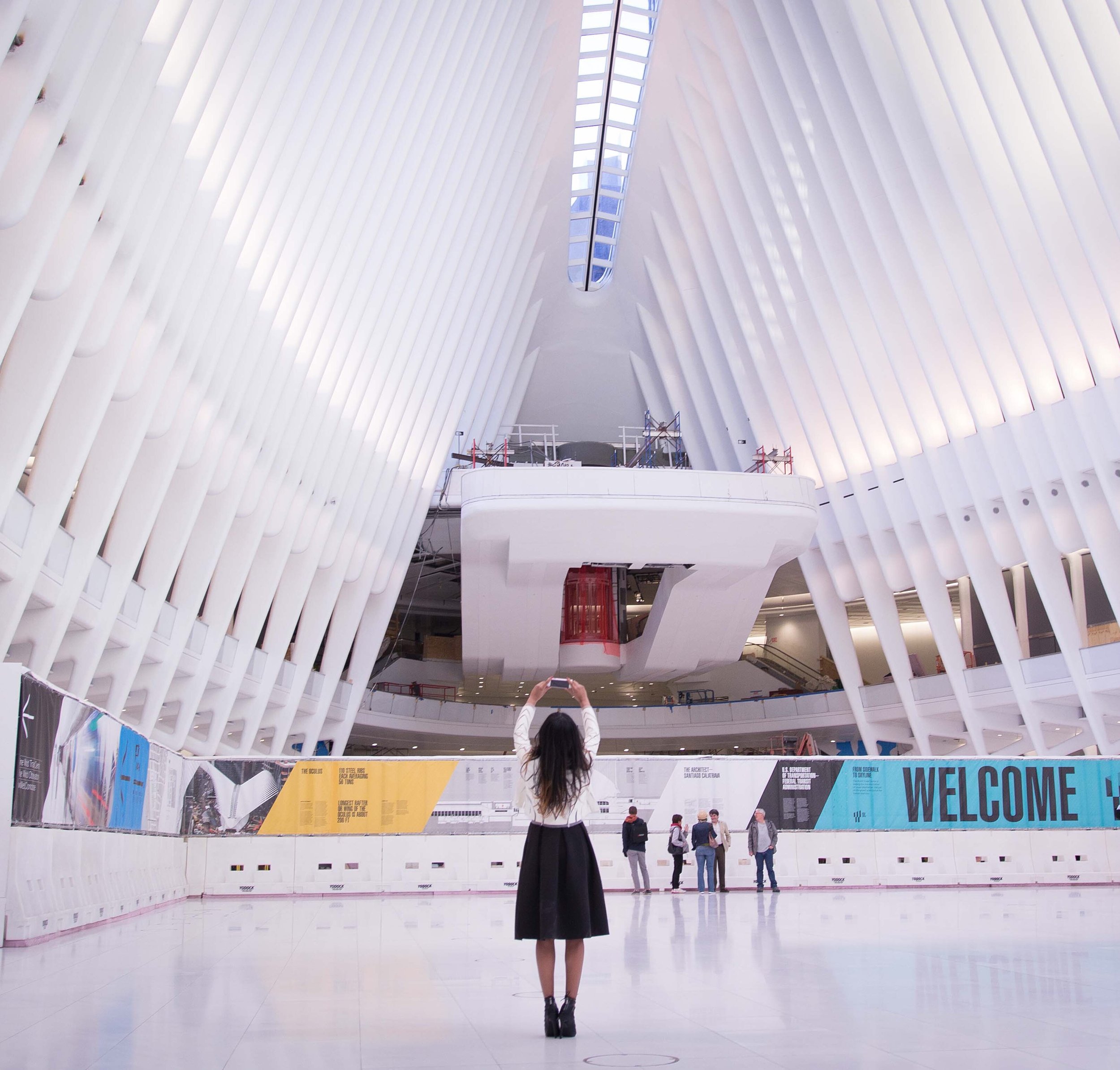Oculus – NYC Transportation Hub
English
Oculus – NYC Transportation Hub
Location: World Trade Center Memorial- Lower Manhattan District
Architect: Santiago Calatrava
Building Uses:
Transportation Hub (Path train, NYC Subway lines 2,3,A,C,E,N,R and Bus M5)
Retail shops
Dining
Public and Private events
Connects the site below grade
The controversial sculptural transportation hub designed by the Spanish architect Santiago Calatrava is reminiscent of a bird being released into the air, with steel wings poised for takeoff. It is one of newest landmarks in New York City. The station was built to replace one that served PATH trains to and from New Jersey, and that was destroyed along with the Twin Towers in 2001.
After personally waiting 12 years to see how the transportation hub was going to turn out and how it was going to impact that area, it opened its doors on March 3, 2016, and I was finally there. It’s still under construction, but the main area is open to the public along with the PATH train station.
An oculus is a circular opening in the center of a space. This is what the transportation hub is. Its prefabricated structures feature arching glass with no supportive columns in the free open space, which made this construction project uniquely challenging.
The glass ceilings reach 160 feet high, making the open space even more spectacular. Light filters through the glass, reflecting throughout the interior white space, and changes colors throughout the day because of the sunlight. The marble floors lead visitors to their destination.
My first impression was the awe and amazement that crossed the faces of commuters, tourists, and locals entering the Oculus for the first time. How can we tell nowadays if a space is accepted by its visitors? They take out their camera, snap a picture or take a selfie, and share it with the world. Around 100,000 people pass by the hub during the day, and that’s what people do when they first experience it.
According to Calatrava, “It is a monument to life, it is a monument of faith in this city and a monument dedicated to the people.”
Facts about the Oculus
Third largest transportation center in NYC.
At night the illuminated building serves as a lantern in its neighborhood.
Has high performance lighting and integrated climate control
Is approximately 365 Ft long and 140 ft across.
Has 110 steel ribs with an average of 56 tons each.
The longest wing is 200 ft long.
Pictures I took of the construction progress :
My Image in the space
The black and white outfit camouflages in the space. An off white tulle patched jacket resembles how the structure looks from the interior and exterior of the place. A black A- line skirt, red lipstick and black top with strappy sandals pulls the look together making it contemporary chic.
Photography by : Edwing Roncal
Instagram @ Edroncal
Español
Oculus – Centro de transporte de la Ciudad de Nueva York
Ubicación: World Trade Center Memorial - Distrito del Bajo Manhattan
Arquitecto: Santiago Calatrava
Usos:
Centro de transporte (Rutas de tren, Líneas subterráneas de NYC 2, 3, A, C, E, N y R)
Centro comercial
Restaurantes
Eventos públicos y privados
Sirve de conector del lugar de manera soterrada
El controversial y escultórico Centro de transporte diseñado por el arquitecto español Santiago Calatrava es la reminiscencia de un ave liberada al aire, con alas de acero posicionadas en toma de vuelo. Es uno de los hitos más nuevos de la Ciudad de Nueva York. La estación fue construida para reemplazar una de las vías del tren para y desde Nueva Jersey, que fue destruida durante los atentados a las Torres Gemelas en el año 2001
Después de esperar personalmente 12 años para ver como el centro de transporte estaba resultando y de cómo iba a impactar aquella área, abrió sus puertas el 3 de Marzo del 2016, y finalmente estuve ahí. Aún sigue en construcción, pero el área principal está abierta al público, así como la estación de vías del tren PATH.
Un óculo (Oculus) es una abertura circular en el centro de un espacio. Esto es lo que un centro de transporte es. Sus estructuras prefabricadas con vidrios arqueados sin columnas de soporte en el espacio abierto, hacen de este proyecto de construcción singularmente desafiante.
Los techos de vidrio alcanzan los 160 pies de altura, haciendo el espacio aún más espectacular. Los filtros de luz a través del vidrio, reflejan todo el interior del espacio blanco, tornándolo de diferentes colores conforme pasa el día, debido a la luz solar. Los pisos de mármol llevan a cada uno de sus visitantes a sus destinos.
Mi primera impresión fue la admiración y el asombro en el rostro de los viajeros, turistas y locales que entran en el Oculus por primera vez. ¿Cómo podemos saber hoy en día si un espacio es aceptado por sus visitantes? Ellos tomarán sus cámaras fotográficas, capturarán una imagen o se tomarán una “selfie”, y la compartirán con el mundo. Alrededor de 100,000 personas transitan por el Centro durante el día, y eso es lo primero que las personas hacen cuando lo experimentan.
De acuerdo con Calatrava, “Es un monumento a la vida, es un monumento de fe en esta ciudad y un monumento dedicado a la gente.”
Datos del Oculus
Es el tercer centro de transporte más grande de la ciudad de Nueva York.
En la noche el edificio actúa como linterna en su vecindad.
Tiene un alto desempeño de iluminación y un control de clima integrado
Tiene aproximadamente 365 pies de longitud por 140 pies de ancho.
Cuenta con 110 costillas o soportes de acero de 56 toneladas en promedio cada una.
El ala más larga tiene una longitud de 200 pies.
























